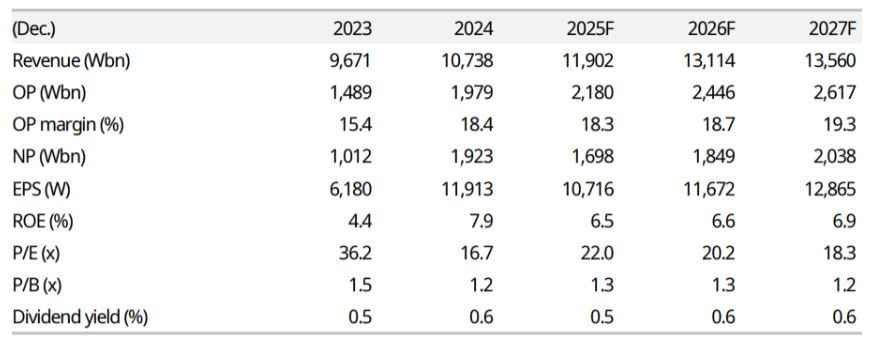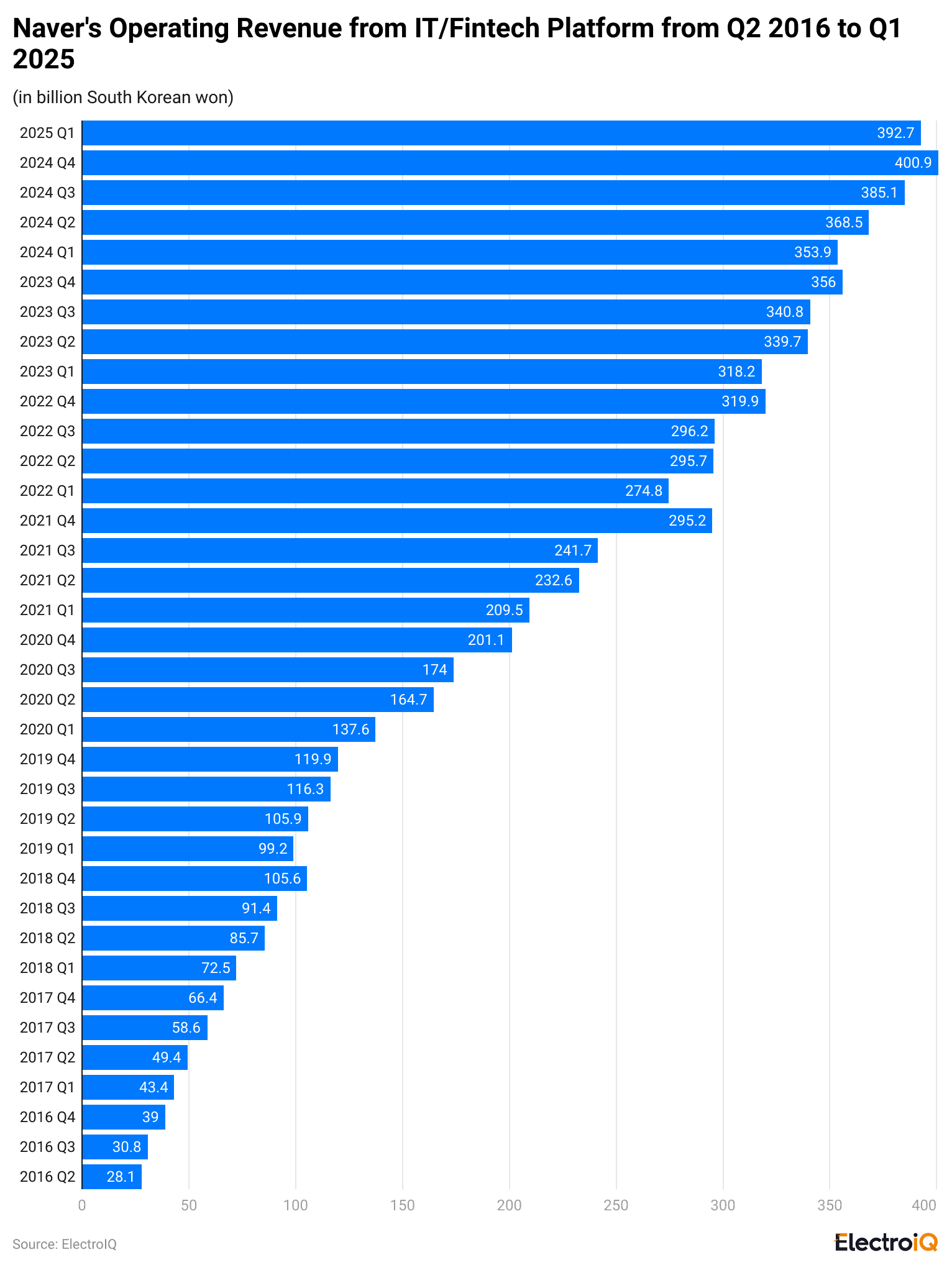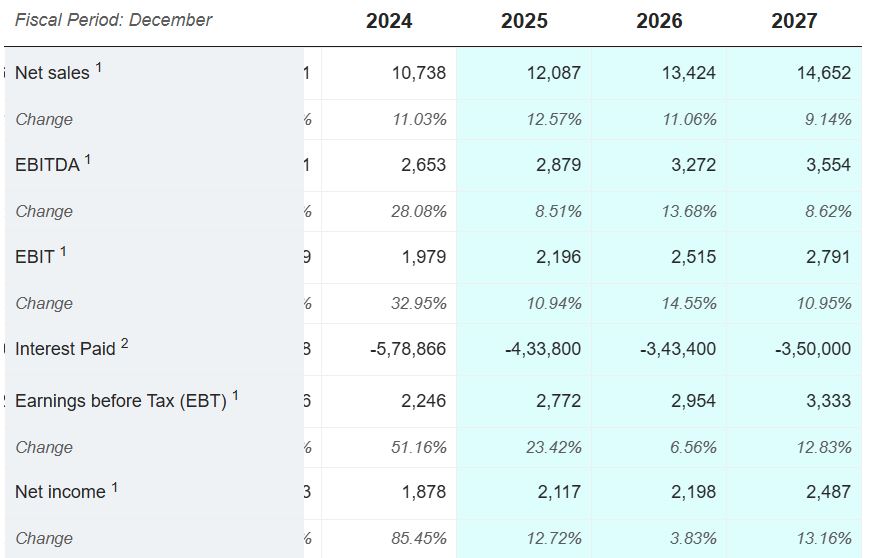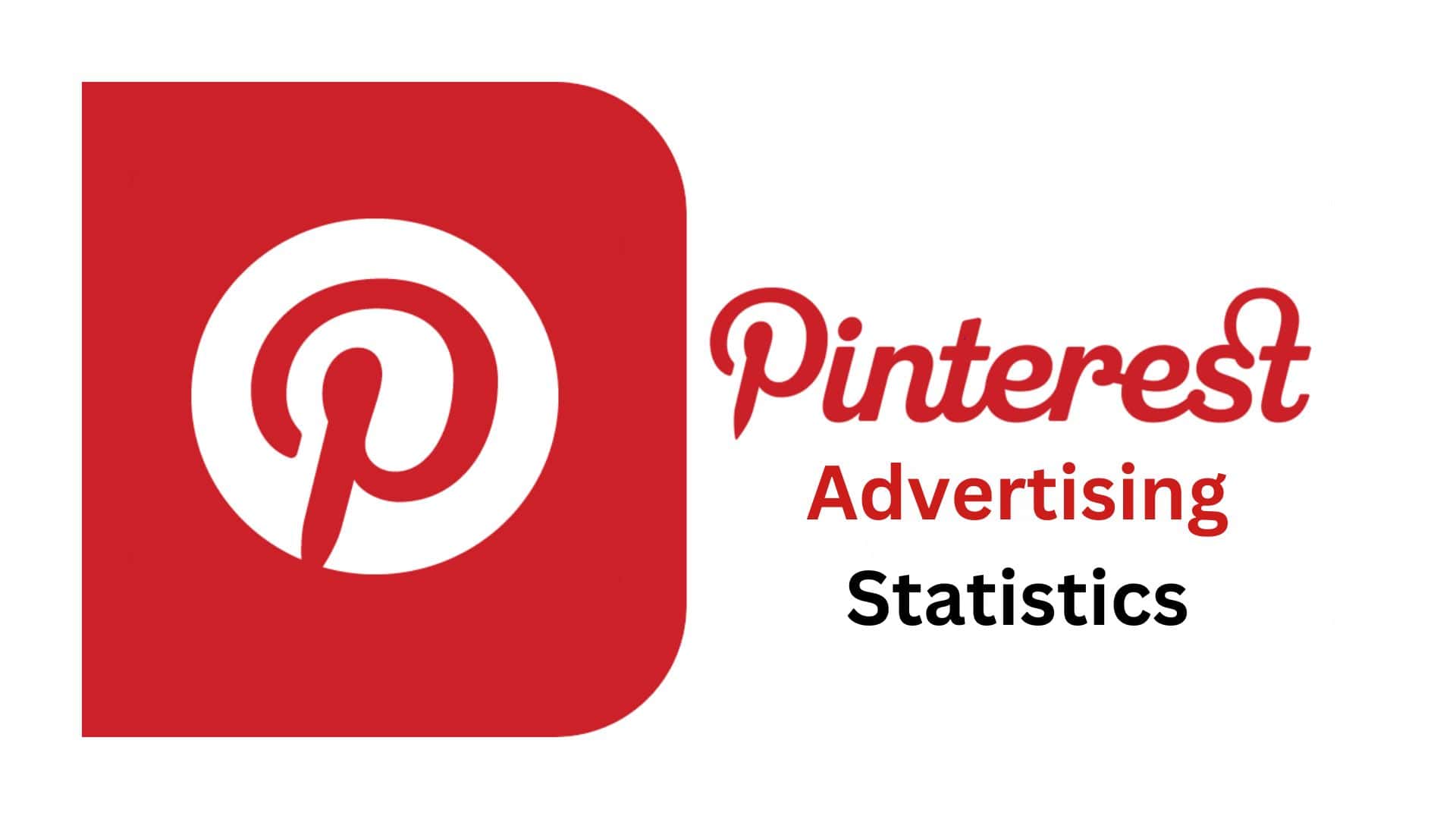NAVER Statistics By Revenue and Facts (2025)
Updated · Nov 24, 2025

Table of Contents
Introduction
NAVER Statistics: NAVER, the largest internet corporation in Korea, saw its growth in 2024 increase across search, advertising, commerce, fintech, and cloud services, among others. Awash with the AI-driven way brought on by its measures and hence the rapid growth of digital payments and e-commerce, its revenue, profit, and productivity showed sharp increases. In conjunction with rights holders, NAVER fortified its platform security through counterfeit-detection technology.
The company’s 2027 predictions of continued growth made it one of the most powerful leaders in Korea’s digital economy. The NAVER 2024 statistics on revenues, profits, business-segment growth, market share in Korea, and a key subsidiary (Webtoon), which had major news in 2024, are presented in this article.
Editor’s Choice
- NAVER’s revenue went up to ₩9,671 billion in 2023 and ₩10,738 billion in 2024 and is expected to be ₩13,560 billion by 2027.
- Operating profit increased from ₩1,489 billion in 2023 to ₩1,979 billion in 2024, and it will be ₷2,617 billion by 2027.
- The operating margin was 15.4% in 2023 and is projected to reach 19.3% in 2027, up from 18.4% in 2024.
- Net profit expanded significantly, nearly doubling from ₩1,012 billion in 2023 to ₩1,923 billion in 2024, and is expected to reach ₩2,038 billion in 2027.
- EPS growth (earnings per share) was from ₩6,180 in 2023 to ₩11,913 in 2024, and it is expected to be ₩12,865 in 2027.
- ROE( return on equity) improved from 4.4% in 2023 to 7.9% in 2024, and then it will continue to hover between 6.5–6.9% throughout the forecast years.
- P/E ratio slumped steeply from 36.2 in 2023 to 16.7 in 2024, and expectations are that it will stabilise at 18–22x.
- In Q1 2025, Fintech revenue totalled around ₩393 billion, up 11% year over year.
- The search platform contributed ₩1.0602 trillion with a year-on-year growth rate of 6.3%.
- The total commerce revenue reached ₩985.5 billion, thus indicating 35.9% year-on-year growth.
- The fintech segment posted revenue of ₩433.1 billion, up 12.5% YoY, and NAVER Pay’s payment volume increased by ₩22.7 trillion, up 21.7% YoY.
- Regarding fake product detection, NAVER recorded a 95.6% proactive response rate.
- More than 1,000 counterfeit stores are blocked every month thanks to enhanced surveillance methods.
- Net sales are expected to grow from ₩10,738 billion in 2024 to ₩14,624 billion in 2027.
- EBITDA goes up from ₩2,653 billion in 2024 to ₩3,552 billion in 2027.
- Interest payments decrease sharply from ₩578,866 million in 2024 to ₩350,000 million in 2027.
- Net income is expected to increase from ₩1,878 billion in 2024 to ₩2,491 billion in 2027.
History of NAVER
- 1999: Naver Comm was founded by Lee Hae-jin and launched the Naver search service alongside Junior Naver for children.
- 2000: Naver merged with Hangame Communications, creating the basis for NHN; Naver also introduced “comprehensive search” that displayed results by content type on one page.
- 2001: The combined company adopted the name NHN Corporation while continuing to operate Naver and Hangame brands.
- 2002: Naver launched Knowledge iN on October 7 as a user Q&A knowledge platform, which later became a core differentiator in Korean search.
- 2003: Naver Blog service was initiated and evolved from “Paper” in June to “Blog” in October, expanding the portal’s UGC footprint.
- 2004: Naver Webtoon service was introduced, laying the groundwork for a global webcomic platform.
- 2005: Naver rolled out real-time rising search terms on the portal’s main page.
- 2011: NHN’s Japan team launched LINE in June following the Tōhoku earthquake, rapidly growing into a leading messaging app in Japan and across Asia.
- 2013: NHN split its businesses; the portal unit became Naver Corporation on August 1, and the corporate name change to Naver Corporation was formalized on October 1. In June, Naver opened its first self-owned data center, GAK Chuncheon.
- 2015: Naver incubated Webtoon as an internal company-in-company unit, preparing it for standalone scale.
- 2017: Naver Webtoon was spun off as a wholly owned subsidiary, accelerating global expansion of the comics platform.
- 2021: LINE Corporation completed its business integration with Yahoo Japan under Z Holdings on March 1, controlled by A Holdings, a joint venture of SoftBank and Naver; Naver completed the acquisition of Wattpad in May for over US$600 million, later combining Wattpad Studios and Webtoon Studios.
- 2022: Naver agreed to acquire Poshmark for about US$1.2 billion to strengthen its commerce ecosystem.
- 2023: The Poshmark acquisition closed in January; Naver opened its second hyperscale data center, GAK Sejong, in November to support AI and cloud growth.
- 2024: WEBTOON Entertainment, controlled by Naver, filed for a U.S. IPO in May and listed on Nasdaq in June, with shares rising about 14% on debut.
- 2025: Naver disclosed the purchase of an additional 70.5% stake in Spain’s Wallapop, consolidating control to advance its European C2C strategy.
Fun Facts About NAVER
- Name meaning: The name NAVER comes from the verb “navigate” plus the suffix “-er,” so it literally means “a person who navigates information on the internet.”
- Early Korean search pioneer: NAVER was founded on 2 June 1999 and was the first major Korean web portal to operate its own domestic search engine, instead of relying on foreign technology.
- Invented “comprehensive search” before global rivals: In August 2000, NAVER introduced a “comprehensive search” page that shows results from news, blogs, images, communities and other services together, several years before similar unified result pages became standard on global search engines.
- Knowledge iN beat Yahoo! Answers to market: NAVER launched its user Q&A service Knowledge iN in October 2002, about three years before Yahoo! Answers. Today it has built up hundreds of millions of questions and answers, and has been used as a research case in academic studies on online communities.
- Massive social Q&A database: Research has shown that Knowledge iN accumulated around 2.6 million Q&A pairs in just its first few years, and by the early 2020s the service had logged roughly 300 million questions and 500 million answers, for about 800 million pieces of knowledge data overall.
- Junior NAVER as Korea’s last big kids’ portal: The children’s portal Junior NAVER (Juniver) started in 1999 and offers games, cartoons and homework help. After rival services such as Daum Kids and Yahoo Kids closed, Junior NAVER became the only remaining large-scale children’s portal site in Korea.
- NAVER Webtoon is a global comics powerhouse: NAVER launched Naver Webtoon in 2004; by 2023 the Webtoon platform was recording about 85.6 million monthly active users worldwide and more than 125 billion views per year, making it the leading webcomic platform in the United States and many other markets.
- Big earnings for digital comic creators: Between 2020 and 2021 Webtoon paid more than USD 27 million to over 120,000 English-language creators, and top Korean creators can earn around USD 250,000 per year, with the single highest earner reported at about USD 9 million in 2021.
- LINE messenger was born inside NAVER’s group: The popular messaging app LINE was created in 2011 by NHN Japan, then a subsidiary of NAVER, after the Tōhoku earthquake disrupted phone networks. LINE later became Japan’s largest social network and is used by more than 70% of the Japanese population, with around 97 million users in Japan alone.
- Number 1 messaging app in multiple countries: By focusing on local culture and services such as stickers, payments and news, LINE became the number 1 messaging app not only in Japan but also in Taiwan and Thailand, turning NAVER’s spin-off into one of East Asia’s most influential “super apps.”
- Robot-friendly 1784 headquarters: NAVER’s second HQ building “1784” in Seongnam is described as the world’s first robot-friendly high-rise office. From 2022 onward it has hosted around 100–110 autonomous “Rookie” delivery robots that share the workspace with roughly 5,200 employees and use a dedicated robot-only elevator system called Roboport.
- Starbucks served by robots: Inside 1784 there is a Starbucks outlet where Rookie robots help deliver drinks around the building, making it widely cited as the first Starbucks location serviced by around 100 delivery robots.
- Green Factory set early sustainability standards: NAVER’s original HQ, the Green Factory in Bundang, opened in 2010 and earned LEED Platinum certification for green building design. Its facade uses automated louvers to control sunlight, and even the emergency stairways are designed to encourage employees to walk by displaying estimated calories burned.
- Strong position in Korean search and maps: Depending on the data source and period, NAVER often holds a very large share of the Korean search market. Some domestic data for 2024 place NAVER at about 56.97% of searches, while Statcounter’s 2025 browser-based data show roughly 38% share, still making it one of the two dominant portals alongside Kakao in a market where even Google Maps has restricted functionality.
- Early move into digital payments: NAVER entered fintech early, starting with Naver Money in 2006 and later launching Naver Pay in 2015. By 2024, Naver Pay reported around 30.68 million users, equivalent to roughly 60% of South Korea’s population, highlighting how deeply NAVER’s services are embedded in everyday consumer payments.
- Online donation culture promoter: In 2005, NAVER launched the Happybean online donation portal and established the Happybean Foundation to encourage small, frequent donations, helping to normalize online philanthropy in South Korea long before such platforms became common worldwide.
NAVER Financial Performance Overview (2023–2027F)

(Source: miraeasset.com)
- The table depicts NAVER’s true financial performance for 2023 and 2024, coupled with estimates for 2025-2027.
- Revenue progresses gradually from ₩9,671 billion in 2023 to ₩10,738 billion in 2024, and analysts predict it to further grow to ₩13,560 billion by 2027F, illustrating continuous business growth.
- Operating profit also goes up significantly, from ₩1,489 billion in 2023 to ₩1,979 billion in 2024, and it is projected to be ₩2,617 billion by 2027F, reflecting efficiency improvements and stronger core operations.
- Operating margin rises from 15.4% in 2023 to 18.4% in 2024, and it is likely to reach 19.3%, indicating NAVER’s stronger profitability.
- The net profit almost doubles from ₩1,012 billion in 2023 to ₩1,923 billion in 2024, but it slips a bit in 2025 before going up again to ₩2,038 billion in 2027F.
- The earnings per share (EPS) jump from ₩6,180 to ₩11,913 between 2023 and 2024, and are expected to reach ₩12,865 by 2027, which means that the shareholders are getting more earnings per share.
- The return on equity (ROE) improves from 4.4% in 2023 to 7.9% in 2024 and then remains within the range of 6.5–6.9% in the subsequent years, indicating that the company is getting higher returns on equity.
- Valuation indicators like the P/E ratio declined sharply by 36.2 in 2023 and further to 16.7 in 2024, indicating that NAVER is more attractively valued relative to earnings.
- The P/E multiple is projected to be in the same range of 18-22x. The P/B ratio is between 1.2 and 1.5, indicating a very conservative valuation.
- Over these years, the dividend yield has remained low at 0.5-0.6%, indicating that NAVER is more concerned with reinvesting earnings than paying high dividends.
- The overall picture painted by the data is one of strong, robust revenue, profit, and efficiency for NAVER, along with a financial improvement expected to be long-term and steady through 2027.
NAVER Operating Revenue From IT/Fintech Platform

(Reference: statista.com)
- Naver’s finance technology, or rather fintech, business was quite successful in the first quarter of the year 2025.
- On account of Naver’s digital payments, banking features, and other related solutions, the revenue earned from this aspect of the business was around 393 billion KRW, and this figure indicates that these financial services are still the primary drivers of Naver’s overall growth while being the second-largest source of revenue for the company after commercials.
- The sum also amounts to an 11% increase from the same quarter last year, which means people are using Naver’s fintech services more and more, and that the company is successfully nourishing this area of its ecosystem.
- NAVER’s revenue growth was strong and evident across all major business segments, i.e., search, commerce, fintech, content, and enterprise services.
- The Search Platform brought in a total of KRW 1.0602 trillion, which is a 6.3% increase from the previous year and a 2.3% increase from the previous quarter.
- It was mainly through improved advertisement performance supported by AI tools such as ADVoost and broadcasting service expansion that this growth has occurred.
- Overall, NAVER’s advertising revenue increased 10.5% YoY and 3.5% QoQ, and the home feed’s daily active users went beyond the 10 million mark owing to the influx of more quality user-generated content and better AI recommendations.
- Commerce contributed KRW 985.5 billion, and this was the highest growth among all segments as it recorded a 35.9% YoY and 14.4% QoQ increase.
- NAVER has made a personalised shopping experience better through its Plus Store, N Delivery, and increased membership benefits.
- NAVER’s marketplace, Smart Store, also captured 12.3% more transaction volume than the previous year, a sign of increased buyer activity and better merchant performance.
- Fintech generated revenue of KRW 433.1 billion, up 12.5% YoY and 5.2% QoQ.
- NAVER Pay was a vigorous developer, recording a total payment amount of KRW 22.7 trillion, 21.7% more than last year.
- The main driver of this was the increasing Smart Store ecosystem and the broader acceptance of NAVER Pay outside of NAVER’s own platforms.
- The Enterprise segment contributed KRW 150.0 billion to revenue, which is a 3.8% YoY and 13.9% QoQ gross-up.
- GPU as a Service (GPUaaS), which is an AI infrastructure product of high demand, is one of the factors which the growth was attributed to, along with the increase in paid LINE WORKS users, indicating that users from businesses are adopting more of the service.
- NAVER’s ad enhancement from AI, increased commerce participation, fintech expansion, and enterprise service offerings were the underlying factors in its performance, as the data represented NAVER’s balanced and continual growth across all divisions.
The Assurance Program of NAVER
- The figures emphasise the various important points illustrating how NEVAR is increasing its counterfeit detection and blocking systems for both commerce and user-generated content platforms.
- One of the most considerable numbers is the 95.6% preemptive response rate for counterfeit items in the retail sector this year.
- This means NAVER successfully identified and acted on the vast majority of counterfeit-related risks before they reached users.
- Additionally, NAVER enforces strict seller monitoring, blocking more than 1,000 stores per month through measures such as “one-strike-out” policies and the counterfeit product clean program, which removes sellers with repeated violations.
- As a result, NAVER not only recognised but also took action on nearly all the risks connected to counterfeits before they got to the end users.
- Moreover, NAVER does not compromise on seller surveillance, and as a result, more than 1,000 stores are closed off every month by using such methods as “one-strike-out” practices and the anti-counterfeit product clearance program, which eliminates sellers with repeated violations.
- In addition, NAVER is broadening its collaboration network, expecting to be in touch with about 300 rights owners and brands in 2025 to make counterfeit detection stronger.
- This partnership strategy covers asking for expert verification through specialised appraisal institutions and maintaining its long-term participation, which is over a decade of participation in the Korean Intellectual Property Office’s Anti-Counterfeit Product Distribution Prevention Council.
- The impact of the measures taken can be seen on community platforms. The number of reports for the sale of counterfeits in cafes, blogs, and bands has gone down significantly.
- Reported instances in the first half of 2025 were 50% lower when compared to the same period last year, indicating the success of measures such as keyword-based blocking, limited community creation, and sophisticated AI-based filtering tools.
- Starting September 1, NAVER will launch a new Intellectual Property Clean Program as part of its ongoing efforts.
- In considering that a seller violates intellectual property rights more than 20 times within a week, NAVER takes measures, which are increasingly severe as consequences: for the first violation, a warning; for the second, a caution; and for the third or beyond, then, the seller faces strict sanctions.
- The seller’s whole store is made invisible to search results of shopping temporarily for the duration of the repeated violations.
- Such tiered actions further strengthen NAVER’s plan of preserving a more secure, counterfeit-free zone not only for buyers but also for rights holders across its channels.
NAVER Income Statement

(Source: marketscreener.com)
- According to Marketscreener, the financial performance of NAVER is expected to produce similar results from 2024 to 2027.
- Overall, the company is predicted to experience steady growth each year, at would reflect in the increases of sales, operating profits, and net income.
- Net sales increase from 10,738 billion KRW in 2024 to 14,624 billion KRW in 2027. This represents yearly growth rates of 9% to 12.6%, signalling a robust yet slowly coming to a halt revenue uplift.
- EBITDA for the company also goes up every year from 2,653 billion KRW in 2024 to 3,552 billion KRW in 2027.
- The EBITDA growth rate starts with a very high 28.08% in 2024 and subsequently slows down to single-digit growth in the next years, which shows that the company’s profitability is getting better but at a slower pace over the years.
- EBIT is along the same lines, starting from 1,979 billion KRW in 2024 and going to 2,784 billion KRW in 2027.
- The same goes for the growth rate, which drops slightly each year, starting from 32.95% and then going to about 10–14%, which points to better operational efficiency.
- The table also shows the interest paid every year, which is represented by negative values.
- These amounts are noticeably lower in 2024 at -578,866 million KRW and in 2027 at -350,000 million KRW.
- Lower interest expenses are typically an indicator of improved debt management or refinancing at more favourable rates.
- Earnings before tax (EBT) indicate a persistent upward trend, with an increase from 2,246 billion KRW in 2024 to 3,433 billion KRW in 2027.
- The most significant jump occurs in 2024 with a growth rate of 51.16% followed by more slight increase in the subsequent years. This is a reflection of the company’s overall profit trend.
- Net income goes up from 1,878 billion KRW in 2024 to 2,491 billion KRW in 2027.
- The largest increase is seen in 2024 with 85.45% growth, and then the growth rates become quite stable in the range of 4% to 13%. This indicates NAVER is expected to maintain healthy profitability as it scales.
Conclusion
According to the NAVER Statistics, it is quite clear that NAVER is on a steady path of growth and strengthening its position in various digital industries. The company is expected to continue increasing its revenue, operating profit, and net income through 2027, indicating long-term financial stability. Non-stop growth in commerce, fintech, and AI-led advertising and enterprise services are among the factors that support NAVER’s diversified growth strategy.
Furthermore, its effective counterfeit control systems play a vital role in enhancing platform trust and user safety. With rising EPS, manageable interest expenses, and stable valuation ratios, NAVER remains well positioned for future expansion. The continuous focus on innovation will keep the company as a competitor in the Korean digital market.
Sources
FAQ.
NAVER’s revenue went up from ₩9,671 billion in 2023 to ₩10,738 billion in 2024. It is expected to keep climbing and will hit ₩13,560 billion by 2027, thus confirming the prediction of steady long-term growth.
The segment that recorded the highest growth is Commerce with an impressive revenue of ₩985.5 billion and 35.9% year-over-year growth. The growth was boosted by Smart Store expansion, enhanced delivery services, and personalised shopping.
NAVER successfully accomplished a 95.6% preemptive response rate for counterfeit product detection, and it shuts down more than 1,000 stores a month for violations. Plus, it works with approximately 300 rights holders and intends to roll out an Intellectual Property Clean Program with even stricter penalties.
NAVER’s fintech revenues in Q1 2025 were recorded at ₩393 billion, which is an 11% increase compared to the same period last year. The total payment volume of NAVER Pay reached ₵22.7 trillion, which is a significant increase of 21.7% year-on-year.
The net income of NAVER is predicted to climb from ₩1,878 billion in 2024 to ₩2,491 billion in 2027. The operating profit, EBITDA, and earnings before tax also show a consistent annual rise reflecting stable profitability and efficient operations.

I hold an MBA in Finance and Marketing, bringing a unique blend of business acumen and creative communication skills. With experience as a content in crafting statistical and research-backed content across multiple domains, including education, technology, product reviews, and company website analytics, I specialize in producing engaging, informative, and SEO-optimized content tailored to diverse audiences. My work bridges technical accuracy with compelling storytelling, helping brands educate, inform, and connect with their target markets.










